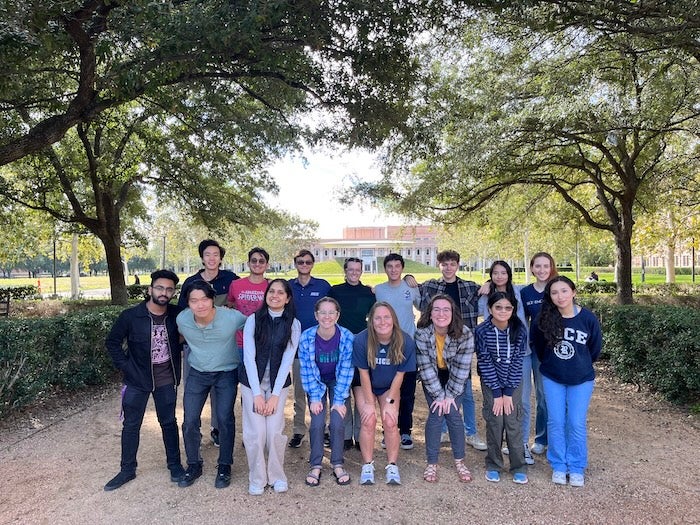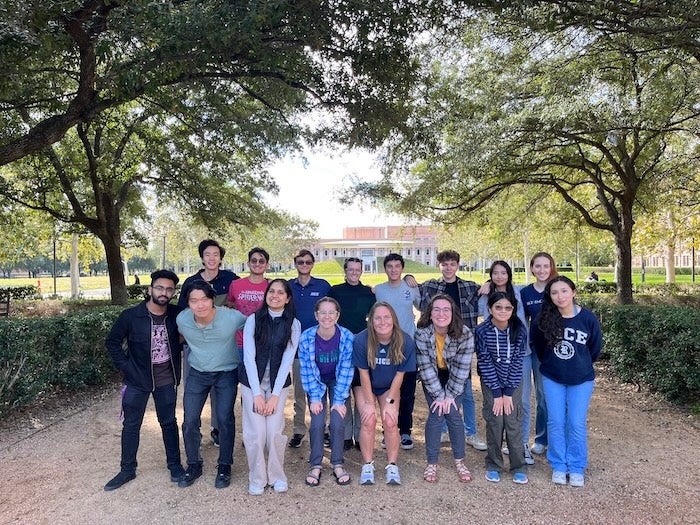An interdisciplinary group of Rice University students has been selected to compete in the Phase 3 final round of the U.S. Department of Energy’s (DOE) 2024 Collegiate Wind Competition (CWC).
This year marks Rice’s inaugural trip to compete in the finals of the prominent undergraduate wind energy contest.
“This is only our second year working towards the competition,” said junior Raj Anthony, president of the Rice Wind Energy team. “To make the finals is no small feat. It wouldn’t have been possible without everyone’s hard work and passion for the team.”

For the CWC, the team from Rice took on three main tasks: designing and building a wind turbine in Rice’s design labs; developing a site plan and 20-year financial analysis for a cost-effective and conscientious wind farm in the Great Lakes; and connecting with students, professors and industry experts in the Rice community, Houston community and beyond.
As part of the challenge, the turbine’s foundation structure was built to fit in sand and water to allow the turbine to withstand winds up to 50 miles an hour. The team’s project features a stable foundation and durable turbine that regulates power and revolutions per minute. It also produces minimal vibrations, shuts off quickly and is aerodynamic.
“Our turbine blades can pitch in and out of the wind to help our turbine safely handle higher wind speeds and allow our turbine to quickly and efficiently emergency stop on command,” Anthony said. “Our blade pitching system also allows us to regulate turbine power output by giving us precise control over the turbine’s revolutions per minute.”
Held annually since 2014, the CWC prepares college students for jobs in the wind energy workforce through exposure to real-world wind energy technology, project development and outreach experience.
The competition’s impact is timely and meaningful as the Biden administration has set targets of 80% renewable energy generation by 2030, 100% carbon-free electricity by 2035 and an economy with net-zero carbon emissions by 2050, according to the DOE.
This trend is expected to continue as the Inflation Reduction Act passed in 2022 provides about $370 billion in funding and subsidies for green technologies.
Now the largest source of renewable power in the United States according to the DOE, wind energy can help meet those goals. Moreover, the growing wind energy industry will need a robust workforce to fill a wide range of roles.
The competition finalists are down to 12 teams from 32 teams across the nation, including Rice, Johns Hopkins University, California Maritime Academy, California Polytechnic University, City College of New York, Texas Tech University/South Plains College, University of Colorado at Boulder, University of Texas at Dallas, University of Wisconsin, Virginia Tech University/James Madison University, Pennsylvania State University and Kansas State University. The teams will head to the CWC event scheduled for May 5 at the American Clean Power Association’s CleanPower Conference and Exhibition in Minneapolis.
At the conference, the teams will complete their wind turbine prototype and wind farm site designs, build and test their turbine prototypes and continue to build connections with the wind energy industry and their communities. They also will propose solutions for incorporating offshore wind energy into hybrid systems, identify options for using wind energy and connect with industry and other stakeholders to learn and share what they have learned about the benefits of wind energy in the overall power grid.
The team, Anthony said, has already won the biggest prize: the friendships that have formed from working together as a team.
“Our camaraderie has grown … and our confidence,” Anthony said. “There is happiness and pride in all the work we have done.”
If the team wins in May, the Owls will have a party, Anthony said. But then it’s back to work.
“It has been a lot of work over the past couple of years,” Anthony said. “We will work hard to win, but regardless of how we end up placing, we will be excited to take what we have learned and come back even stronger next year.”

